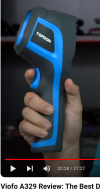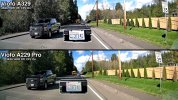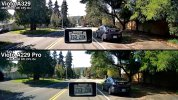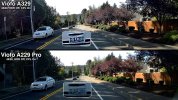Vortex Radar
Well-Known Member
- Joined
- Mar 26, 2014
- Messages
- 877
- Reaction score
- 1,419
- Location
- Seattle, Washington
- Country
- United States
So I've been testing the new Viofo A329 for a bit now and as I'm getting familiar with it, I'm pretty impressed so far. Here's my initial review of the dashcam, followed by some of my thoughts about this new dashcam.
Update: Here's v2 of the video that I'm releasing publicly.
In short, this is essentially an upgraded A229 Pro with a very similar form factor. Both the A229 Pro and A329 have a 4K Starvis 2 IMX678 up front and a 2K Starvis 2 IMX675 in the rear. They'll both be sold side-by-side. Here's a summary of my thoughts so far:
60fps: The A329 adds support for 60fps which can make your videos and help with slow mo, but doesn't make a big difference when it comes to freezing motion. Initially I thought I saw more of a benefit, but looking through a bunch more clips, HDR seems to be a bigger deal when it comes to detail capture, but not so much the 60 fps option. The rear cam always records at 30 fps.
Bitrate: While earlier test firmwares allowed us to run at nearly 100 Mb/s, due to reliability issues, 65 Mb/s is now the balance Viofo is going for. This is true for 1CH, 2CH, 4K60, and 4K30HDR options. There's no bitrate increase or decrease when switching modes or adding/removing a second cam.
1CH / 2CH / 3CH: Unlike the A229 Pro which could do 1, 2, or 3 channels, the A329 only offers 1 or 2 channels. For this reason, the A229 Pro is more versatile given you have the option for an interior cabin cam, front telephoto cam, or exterior rear waterproof cam. This is probably the main advantage I've found for the A229 Pro, the option to add different add-on cams.
SSD: The USB C port from the A229 Pro is now an SSD port, allowing you to plug in an external hard drive up to 4TB. You can record to either the MicroSD or SSD, but not both simultaneously. I can see this being useful for recording super long drives or for keeping the recorded video/audio footage more secure and stored in a hidden location. It works with Windows computers, but unfortunately doesn't work with Macs. It's also picky about USB cables and not all USB C cables allow the dashcam to see the SSD.
Rear cam design: The rear cam's physical design has been updated to add support for Viofo's clip on CPL.
Front / Rear cam cable: The front/rear cable is now no longer USB C. Instead it's the same coax cable used in the original A229 Duo. It's a thinner cable which makes installation easier. I recently ran the wiring for the A229 Pro in both of our vehicles and since the front/rear cable is different with the A329, unfortunately I can't do a plug-and-play swap in either of my cars. Bummer! Oh well.
Cooling: Viofo's improved the cooling here and so the A329 runs cooler than the A229 Pro. I found the temperature variances to be greater after 1 hour of recording compared to 8 hours of recording, but either way I think the updated A329 will be a better option for people driving in hot climates.
WiFi: They've added WiFi 6 which allows file transfer speeds of up to 30 MB/s. In my testing, the A229 Pro can transfer files at just under 10 MB/s while the A329 does so at over 28 MB/s, nearly a 3x jump in transfer speed.
Misc: There's also a bunch of small changes. For example, the CPL alignment line is now on the bottom of the lens, making it easier to align the CPL when you're sitting in the car. There's an option to change the color of the text stamped onto the video footage which is especially helpful for people who drive white cars. There's also a MicroHDMI port added that allows you to connect the dashcam to an external display both while driving or later on during video playback.
Overall Thoughts: This is a welcome upgrade over the A229 Pro. It's still early and I wouldn't be surprised to see more firmware updates in the pipeline, but based on what I've seen so far, I can see this becoming my new default recommendation over the A229 Pro for anyone looking for "the best dashcam." The A229 Pro will be the preferred option if you need an interior cabin camera or you wanna add on Viofo's optional telephoto up front.
For more discussion, here's some additional thoughts on whether or not I think it's worth upgrading to the A329.
Update: Here's v2 of the video that I'm releasing publicly.
In short, this is essentially an upgraded A229 Pro with a very similar form factor. Both the A229 Pro and A329 have a 4K Starvis 2 IMX678 up front and a 2K Starvis 2 IMX675 in the rear. They'll both be sold side-by-side. Here's a summary of my thoughts so far:
60fps: The A329 adds support for 60fps which can make your videos and help with slow mo, but doesn't make a big difference when it comes to freezing motion. Initially I thought I saw more of a benefit, but looking through a bunch more clips, HDR seems to be a bigger deal when it comes to detail capture, but not so much the 60 fps option. The rear cam always records at 30 fps.
Bitrate: While earlier test firmwares allowed us to run at nearly 100 Mb/s, due to reliability issues, 65 Mb/s is now the balance Viofo is going for. This is true for 1CH, 2CH, 4K60, and 4K30HDR options. There's no bitrate increase or decrease when switching modes or adding/removing a second cam.
1CH / 2CH / 3CH: Unlike the A229 Pro which could do 1, 2, or 3 channels, the A329 only offers 1 or 2 channels. For this reason, the A229 Pro is more versatile given you have the option for an interior cabin cam, front telephoto cam, or exterior rear waterproof cam. This is probably the main advantage I've found for the A229 Pro, the option to add different add-on cams.
SSD: The USB C port from the A229 Pro is now an SSD port, allowing you to plug in an external hard drive up to 4TB. You can record to either the MicroSD or SSD, but not both simultaneously. I can see this being useful for recording super long drives or for keeping the recorded video/audio footage more secure and stored in a hidden location. It works with Windows computers, but unfortunately doesn't work with Macs. It's also picky about USB cables and not all USB C cables allow the dashcam to see the SSD.
Rear cam design: The rear cam's physical design has been updated to add support for Viofo's clip on CPL.
Front / Rear cam cable: The front/rear cable is now no longer USB C. Instead it's the same coax cable used in the original A229 Duo. It's a thinner cable which makes installation easier. I recently ran the wiring for the A229 Pro in both of our vehicles and since the front/rear cable is different with the A329, unfortunately I can't do a plug-and-play swap in either of my cars. Bummer! Oh well.
Cooling: Viofo's improved the cooling here and so the A329 runs cooler than the A229 Pro. I found the temperature variances to be greater after 1 hour of recording compared to 8 hours of recording, but either way I think the updated A329 will be a better option for people driving in hot climates.
WiFi: They've added WiFi 6 which allows file transfer speeds of up to 30 MB/s. In my testing, the A229 Pro can transfer files at just under 10 MB/s while the A329 does so at over 28 MB/s, nearly a 3x jump in transfer speed.
Misc: There's also a bunch of small changes. For example, the CPL alignment line is now on the bottom of the lens, making it easier to align the CPL when you're sitting in the car. There's an option to change the color of the text stamped onto the video footage which is especially helpful for people who drive white cars. There's also a MicroHDMI port added that allows you to connect the dashcam to an external display both while driving or later on during video playback.
Overall Thoughts: This is a welcome upgrade over the A229 Pro. It's still early and I wouldn't be surprised to see more firmware updates in the pipeline, but based on what I've seen so far, I can see this becoming my new default recommendation over the A229 Pro for anyone looking for "the best dashcam." The A229 Pro will be the preferred option if you need an interior cabin camera or you wanna add on Viofo's optional telephoto up front.
For more discussion, here's some additional thoughts on whether or not I think it's worth upgrading to the A329.
Last edited:








